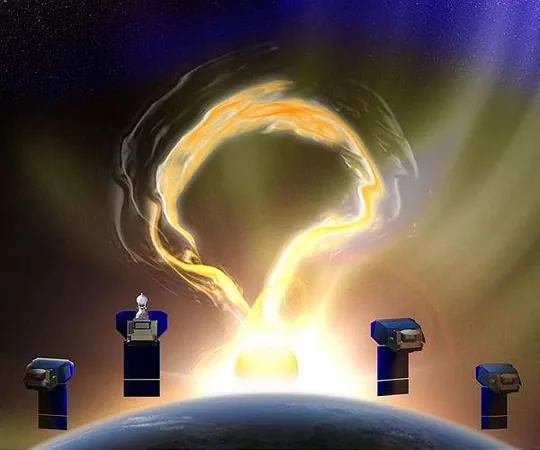
NASA's PUNCH Mission Kicks Off with Innovative Solar Wind Observations!
2025-03-24
Author: Wei
NASA's PUNCH Mission Kicks Off with Innovative Solar Wind Observations!
The U.S. Naval Research Laboratory's (NRL) Narrow Field Imager (NFI) is now operational, following its launch aboard a SpaceX Falcon 9 rocket as part of NASA's groundbreaking Polarimeter to Unify the Corona and Heliosphere (PUNCH) mission on March 11. The NFI successfully deployed from the launch vehicle on March 12 and has begun its mission to gather pivotal data from low Earth orbit.
PUNCH is an ambitious endeavor comprised of four satellites that will work in concert to explore the inner heliosphere. This mission aims to provide an unparalleled three-dimensional view of the realm where the solar corona morphs into the solar wind. Following a three-month commissioning phase, PUNCH is set to enter a two-year scientific phase that promises essential insights into the formation and dynamics of solar wind.
The NFI, a compact coronagraph equipped with an external occulter, is instrumental in this mission. It effectively blocks direct sunlight, allowing it to capture detailed images of the faint corona and the surrounding background starfield around the Sun. The optical system features a compound lens assembly and a polarizing filter wheel. Impressive imaging capabilities are provided by a CCD camera with a high-resolution 2K x 2K active detector. Developed under the auspices of NASA, the NFI's primary objective is to track the evolution of the Sun’s atmosphere into the space environment.
Robin Colaninno, Ph.D., the head of the NRL Coronal and Heliospheric Physics Section, emphasized the significance of this technology: “The launch and deployment of NRL's Narrow Field Imager aboard the PUNCH mission marks a significant step forward in our ability to understand the dynamic processes that drive space weather. By imaging the transition of the Sun's atmosphere to the solar wind, we're gaining crucial insights that will ultimately improve our ability to predict and mitigate the impacts of these powerful events on Earth and in space.”
The importance of understanding space weather cannot be overstated, particularly when considering the potential impacts of phenomena such as coronal mass ejections (CMEs) and corotating interaction regions (CIRs). These events originate from the Sun and evolve as they traverse the vast distance between the solar corona and Earth, particularly through the poorly monitored inner heliosphere.
PUNCH is expected to capture pivotal data on the development of CMEs, shedding light on their origins and trajectories. This information is vital for accurately forecasting the Earth-bound effects of solar activity, which can lead to satellite damage, communication blackouts, and even massive power outages on our planet. Moreover, improved forecasting will enhance the safety and efficiency of space-based systems and exploratory missions far beyond Earth’s atmosphere.
Stay tuned as we continue to follow the PUNCH mission and its potential to revolutionize our understanding of solar phenomena! This could change everything we thought we knew about the Sun!



 Brasil (PT)
Brasil (PT)
 Canada (EN)
Canada (EN)
 Chile (ES)
Chile (ES)
 Česko (CS)
Česko (CS)
 대한민국 (KO)
대한민국 (KO)
 España (ES)
España (ES)
 France (FR)
France (FR)
 Hong Kong (EN)
Hong Kong (EN)
 Italia (IT)
Italia (IT)
 日本 (JA)
日本 (JA)
 Magyarország (HU)
Magyarország (HU)
 Norge (NO)
Norge (NO)
 Polska (PL)
Polska (PL)
 Schweiz (DE)
Schweiz (DE)
 Singapore (EN)
Singapore (EN)
 Sverige (SV)
Sverige (SV)
 Suomi (FI)
Suomi (FI)
 Türkiye (TR)
Türkiye (TR)
 الإمارات العربية المتحدة (AR)
الإمارات العربية المتحدة (AR)